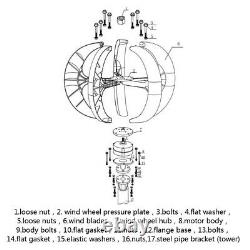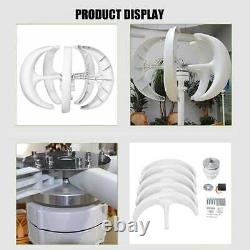Wind turbine 400W 12/24V generator charger electricity Mobil home. Free energy









Please specify the desired voltage when purchasing: 12v, or 24v. For home use, for surveillance use, for boat / marine use, for wind solar hybrid street light use.
Wind turbines, low wind starting speed, high efficiency, small size, low vibration and low noise. Look like a beautiful lantern. User-friendly design installation, convenient installation, maintenance and repair of equipment. Using high power tracking microprocessor intelligent control, efficient regulation of current and voltage.The shell is made of die-cast aluminum alloy, with double bearing bracket, the anti-typhoon ability is more strong, safe and reliable. The wind wheel blade with new precision injection molding technology, combined with the optimization of aerodynamic shape design and structural design, high wind power utilization factor, increased annual energy production. The generator using patented permanent magnet rotor alternator, coupled with special stator design, effectively reduce the resistance torque of the generator, while the wind wheel and generator have more good matching characteristics, operation reliability of unity. Rated voltage: 12v / 24v. Safe wind speed: 45m / s.
Nominal wind speed: 12 m / s. Starting wind speed: 2m / s. Type of Turbines: Three-phase AC Permanent Magnet synchronous generator.
Quantity of blades: 5 pieces. Operating temperature: -40 to 80. (Note: The mounting bracket is not included). Wind turbine Wind turbine generator.Electricity for Motorhome Mobile Home Bungalow. Renewable energies for use at home and in the countryside. Free energy anywhere, anytime, anytime. Energy in deserted areas not connected to the electricity network.
Solar and wind energies save the consumer a bundle, and costs less than conventional energy sources. Home » Installing and Maintaining a Small Wind Electric System. If you went through the planning steps to evaluate whether a small wind electric system will work at your location, you will already have a general idea about. The amount of wind at your site. The zoning requirements and covenants in your area. The economics, payback, and incentives of installing a wind system at your site. Now, it is time to look at the issues associated with installing the wind system.Siting where finding the best location for your system. Estimating the systems annual energy output and choosing the correct size turbine and tower. Deciding whether to connect the system to the electric grid or not. A wind turbine installer or an electrician installer, should be able to help you install your small wind electric system.
You can install the system yourself but before attempting the project, ask yourself the following questions. Can I pour a proper cement foundation? Do I have access to a lift or a way of erecting the tower safely? Do I know the difference between alternating current (AC) and direct current (DC) wiring?
Do I know enough about electricity to safely wire my turbine? Do I know how to safely handle and install batteries? If you answered no to any of the above questions, you should probably choose to have your system installed by a system integrator or installer. Contact your state energy office and local utility for a list of local system installers. You can also check the yellow pages for wind energy system service providers.A credible installer may provide additional services such as permitting. Find out if the installer is a licensed electrician, and ask for references and check them. You may also want to check with the Better Business Bureau.
With proper installation and maintenance, a small wind electric system should last up to 20 years or longer. Checking and tightening bolts and electrical connections as necessary. Checking machines for corrosion and the guy wires for proper tension. Checking for and replace any worn leading edge tape on the turbine blades, if appropriate. Replacing the turbine blades and/or bearings after 10 years if needed. If you do not have the expertise to maintain the system, your installer may provide a service and maintenance program. Siting a Small Electric Wind System. A wind turbine installer can also help you with finding the best location for your wind system. If you live in complex terrain, take care in selecting the installation site. If you site your wind turbine on the top of or on the windy side of a hill, for example, you will have more access to prevailing winds than in a gully or on the leeward (sheltered) side of a hill on the same property. You can have varied wind resources within the same property.In addition to measuring or finding out about the annual wind speeds, you need to know about the prevailing directions of the wind at your site. In addition to geological formations, you need to consider existing obstacles, such as trees, houses, and sheds. You also need to plan for future obstructions, such as new buildings or trees that have not reached their full height. Your turbine needs to be sited upwind of any buildings and trees, and it needs to be 30 feet above anything within 300 feet. Be sure to leave enough room to raise and lower the tower for maintenance.
If your tower is guyed, you must allow room for the guy wires. Whether the system is stand-alone or grid-connected, you also will need to take the length of the wire run between the turbine and the load house, batteries, water pumps, etc. A substantial amount of electricity can be lost as a result of the wire resistancethe longer the wire run, the more electricity is lost. Using more or larger wire will also increase your installation cost. Your wire run losses are greater when you have direct current (DC) instead of alternating current (AC).
If you have a long wire run, it is advisable to invert DC to AC. Small wind turbines used in residential applications typically range in size from 400 watts to 20 kilowatts, depending on the amount of electricity you want to generate.A typical home uses approximately 10,932 kilowatt-hours of electricity per year (about 911 kilowatt-hours per month). Depending on the average wind speed in the area, a wind turbine rated in the range of 515 kilowatts would be required to make a significant contribution to this demand.
A 1.5-kilowatt wind turbine will meet the needs of a home requiring 300 kilowatt-hours per month in a location with a 14 mile-per-hour (6.26 meters-per-second) annual average wind speed. To help you determine what size turbine you'll need, first establish an energy budget.
Because energy efficiency is usually less expensive than energy production, reducing your home's electricity use will probably be more cost effective and will reduce the size of the wind turbine you need. The height of a wind turbine's tower also affects how much electricity the turbine will generate.
An estimate of the annual energy output from a wind turbine (in kilowatt-hours per year) is the best way to determine whether it and the tower will produce enough electricity to meet your needs. A wind turbine installer or an electrician installer can help you estimate the energy production you can expect. Particular wind turbine power curve. Average annual wind speed at your site. Height of the tower that you plan to use. Frequency distribution of the wind -- an estimate of the number of hours that the wind will blow at each speed during an average year. He will also have to adjust this calculation for the elevation of your site. To get a preliminary estimate of the performance of a particular wind turbine, you can use the following formula. AEO= 0.01328 D2 V3.AEO = Annual energy output (kilowatt-hours/year). D = Rotor diameter, feet. V = Annual average wind speed, miles-per hour (mph), at your site.
Note: the difference between power and energy is that power (kilowatts) is the rate at which electricity is consumed, while energy (kilowatt-hours) is the quantity consumed. Grid-Connected Small Wind Electric Systems. Small wind energy systems can be connected to the electricity distribution system. These are called grid-connected systems. A grid-connected wind turbine can reduce your consumption of utility-supplied electricity for lighting, appliances, and electric heat.
If the turbine cannot deliver the amount of energy you need, the utility makes up the difference. With this type of grid connection, your wind turbine will operate only when the utility grid is available.
During power outages, the wind turbine is required to shut down due to safety concerns. Grid-connected systems can be practical if the following conditions exist. You live in an area with average annual wind speed of at least 10 miles per hour (4.5 meters per second). Utility-supplied electricity is expensive in your area (about 1015 cents per kilowatt-hour).The utility's requirements for connecting your system to its grid are not prohibitively expensive. However, you should contact your utility before connecting to its distribution lines to address any power quality and safety concerns. Your utility can provide you with a list of requirements for connecting your system to the grid.
Wind Power in Stand-Alone Systems. Wind power can be used in off-grid systems, also called stand-alone systems, not connected to an electric distribution system or grid. In these applications, small wind electric systems can be used in combination with other components -- including a small solar electric system -- to create hybrid power systems. Hybrid power systems can provide reliable off-grid power for homes, farms, or even entire communities (a co-housing project, for example) that are far from the nearest utility lines.An off-grid, hybrid electric system may be practical for you if the items below describe your situation. You live in an area with average annual wind speed of at least 9 miles per hour (4.0 meters per second).
A grid connection is not available or can only be made through an expensive extension. You would like to gain energy independence from the utility.
You would like to generate clean power. The item "Wind turbine 400W 12/24V generator charger electricity Mobil home. Free energy" is in sale since Sunday, September 13, 2020. This item is in the category "Business & Industrial\Fuel & Energy\Alternative Fuel & Energy\Wind Power". The seller is "pandystar" and is located in Colmar. This item can be shipped worldwide.- MPN: Does Not Apply
- Brand: Unbranded


